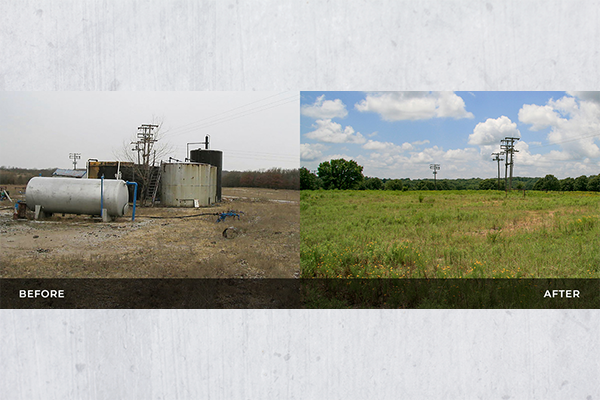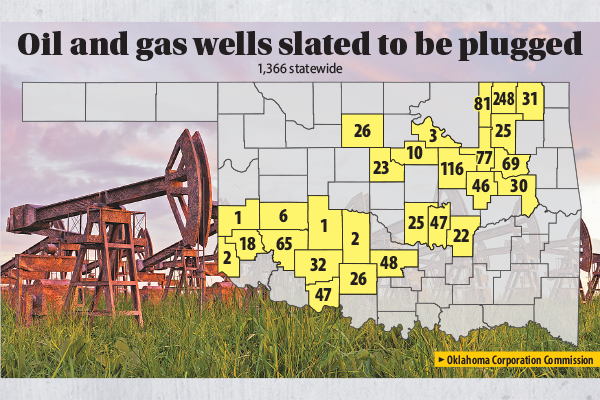OKLAHOMA CITY — Almost 18,000 abandoned oil and gas wells are scattered across Oklahoma, and it would cost an estimated half-billion dollars to plug all of them and remediate the production sites.
The Biden Administration’s Infrastructure Investment and Jobs Act contains $16 billion for plugging and reclaiming orphaned oil and natural gas well sites through the U.S. At least three grants will be available under the federal legislation, said Brad Ice, field operations manager of the Oil and Gas Conservation Division in the Oklahoma Corporation Commission.
One will be $25 million per state, he said. Applications are due by May 15, 2022, and the OGCD will apply, Ice said.
A formula is still being developed for $2 billion that will be divided among the states, Ice said. Components will include a state’s number of orphaned wells, he said. Applications must be submitted by Dec. 30, 2022, and the OGCD will apply, Ice said.
Another grant program will divide $1.5 billion among the states, Ice said. The application period is open-ended, and a state must have received the initial $25 million grant to qualify for the supplemental grant, he said.
The OGCD will continue to meet with officials of the Interstate Oil and Gas Compact Commission and representatives of its member states to discuss the process “as it moves forward,” Ice told the Corporation Commissioners. Oklahoma, Texas, Kansas, New Mexico, Arkansas, Colorado and Louisiana are among the members of the IOGCC.
Prior to the national emphasis on the environment, literally thousands of wells drilled in Oklahoma were abandoned after production tailed off or ceased altogether, leaving behind open wells, unsightly structures and polluted land.
The OGCD documented 17,895 abandoned oil/gas wells in Oklahoma as of Nov. 15, 2021, Ice reported. The wells are classified as abandoned because no individual or company responsible for them can be found, said Matt Skinner, the Corporation Commission’s public information manager.
It would cost the Corporation Commission an estimated $250,794,865 to plug all those wells, and the Oklahoma Energy Resources Board calculates it would cost them $250,110,000 to restore those sites to their original condition, Ice said.
The largest group of wells, identified as “orphaned,” numbers more than 16,500. They have been abandoned, but the Corporation Commission considers them of sufficient quality that perhaps a new operator may be found who’s willing to take over one or more of them and resume production.
The other group, 1,366 oil/gas wells – 200 of which are in southwest Oklahoma – have been abandoned and listed for plugging. Those projects would cost an estimated $14.5 million, ledgers reflect.
CorpComm spent $6.15M to plug 462 orphan wells
The Corporation Commission spent $6.15 million over the past five years (Fiscal Years 2017-21) to plug 462 abandoned oil and gas wells – an average of $13,320 per well – agency records show.
The cost of plugging an oil or gas well varies throughout the state, depending on various factors. The Corporation Commission’s cost estimates are:
District 1: office based in Bristow; encompassing 18 counties including Creek, Pawnee, Payne and Tulsa. Average plugging cost: $9,000 per well. District 1 has 9,933 orphan wells, which would cost $89.4 million to plug, commission staff estimates.
District 2: office based in Kingfisher; comprised of 19 counties, including Oklahoma, Canadian and Logan counties plus the Panhandle. Average plugging cost: $32,000/well. District 2 has 1,013 orphan oil/gas wells, which would cost an estimated $32.4 million to plug.
District 3: office in Duncan; covering 19 counties, including Comanche, Cotton, Jackson, Jefferson, Kiowa, Stephens, Caddo, Grady, Greer, Harmon and Cleveland. Average plugging cost: $20,500/well. District 3 has 1,649 orphan wells that would cost $33.8 million to plug, the commission estimated.
District 4: office in Ada; covering 20 counties, including McCurtain, Pushmataha, Atoka, Bryan, Choctaw, Pittsburg, Pontotoc, Okmulgee and Seminole. Average well-plugging cost: $20,500. District 4 has 3,934 orphan wells, which would cost an estimated $80.6 million to plug.
The commission hires private contractors to plug abandoned wells. Approximately 80 companies are licensed by the commission to plug oil/gas wells in Oklahoma. Most of those companies are based in Oklahoma but some are from Texas, Kansas, Arkansas and Louisiana, records show.
The commission’s fund for plugging abandoned wells is underwritten with a fee paid by current oil and gas operators in the state: .095 of 1% of the gross value of all natural gas and/or casinghead gas produced in the state that’s subject to the gross production tax.
Bond forfeitures also are earmarked for plugging wells, Skinner said. The operator of an oil or gas well is responsible for paying for any damage and for remediating the site when production operations end. An operator is required to post a bond to cover the cost of plugging a well if the operator goes out of business; that bond is $25,000 per operator – not per well – Skinner said.
OERB spends millions to reclaim well sites
Besides the Corporation Commission’s well-plugging efforts, the energy industry itself spends millions to clean up problems that other created.
Nearly three decades ago, in 1993, representatives of Oklahoma’s oil producers and royalty owners, working with the state Legislature, established the Oklahoma Energy Resources Board (OERB); natural-gas producers joined the organization soon after.
“At the heart of our mission is the OERB’s ongoing commitment” to clean up Oklahoma’s abandoned well sites “left to ruin by those who have long since passed or disappeared,” the privatized state agency declares.
Funded through voluntary contributions paid by producers and royalty owners, the OERB’s environmental restorations “cost landowners and taxpayers nothing.”
During its existence the OERB has spent more than $135 million to restore more than 18,000 unattended well sites – “at absolutely no cost to landowners” and “employing Oklahoma contractors along the way,” the agency reports.
“We restore about 750 sites a year,” said Steve Sowers, the agency’s environmental director. That’s equivalent to two sites per day, seven days a week, year-round. “We’re working on 400 to 600 sites at any given time,” he said. Each of those locations is a health and safety hazard, he noted.
Common restoration requirements, according to the OERB, include removing or burying lease roads and location pads; removing equipment, concrete, trash and debris; repairing erosion and saltwater scars on the land; treating hydrocarbons and closing pits.
The average cost is approximately $7,000 per site, the agency said.
If the Oil and Gas Conservation Division receives any of the three new federal grants, “We will plug the wells and the OERB will restore the sites,” Ice told the Corporation Commissioners.
Energy production in Oklahoma for 136 years
Oil and gas exploration and production in Oklahoma have been conducted for 136 years, since before statehood.
The first oil well was drilled near Wapanucka in the Choctaw Nation, Indian Territory, in 1885, but the well was not completed until 1888. Only a small amount of oil and gas was produced before the site was abandoned after the financier fell ill and died.
The first commercially productive well in Indian Territory was the Nellie Johnstone No. 1 drilled near Bartlesville in 1897.
Since then, tens of thousands of oil and gas wells have been drilled throughout the state.
Nobody knows with any precision how many oil and gas wells have been drilled in Oklahoma, but the Corporation Commission’s estimate is perhaps 500,000, Skinner said.
Literally thousands of the wells drilled in Oklahoma were simply abandoned after production ceased, leaving behind open wells, unsightly structures and polluted acreage.
The Corporation Commission was designated as the official regulator of the energy industry in Oklahoma in 1914.



